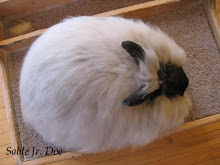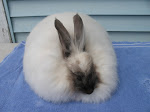At long weekend shows you invariably end up staying in hotels, and when you stay in hotels it is often very difficult to sleep:). After last week's PaSRBA show I found myself with a spell of insomnia on Saturday night in which I got to thinking about the judging of angora wool and the guidelines that individual judges use in assessing it. I thought over the years of how the best wool judges approach an angora coat, and what characteristics they considered the most important.
Everyone has their own opinion of different judges, (and everyone has a favorite to show under), but there are definitely some judges who have the ability to evaluate wool better than others due to personal experience with angoras or simply because they understand the structure of a wool coat and how that relates to it's practical function.
I have noticed a trend in shows lately for judges to evaluate angora wool (of any type) by smoothing it back and forth repeatedly from the rump to the head. They don't actually part the wool and look at the structure of it when they do this, but they do spend a great deal of time fussing with the coat in general and pushing/pulling it in every possible direction. Lately I have been hearing such terms at shows as 'flowability', 'coarseness at the tips', and a large number of other references to condition which are not necessarily relevant to the angora standard.
'Flowability', as near as I can tell, refers to the ability of a coat to flow back down to it's original position in a smooth and fluid manner. I heard several judges use this term last week in PA, and I remember hearing it at the NY State Convention last year as well. It was certainly used in both places to evaluate and place individual rabbits.
A flowing coat can mean a coat that is 'Prime', but other than this it seems to have little relevance to the structure of a coat, other than helping to determine balance and (possibly) texture. It is easy to understand smoothing/ruffling a coat to determine evenness of length since an exercise like this would expose weaknesses along the spine and might also determine a lack of density in the same place. Aside from this, it is impossible to determine the structure of a wool coat without actually parting and examining the wool down to it's base. A coat which 'flows' beautifully and evenly is likely to be LESS dense in most cases simply because a rabbit with more underwool has a thicker coat that is less inclined to move .
This practice of 'swishing the wool' may have originated with the English Angora because judges are continually fluffing and smoothing the coats of that breed every time they are removed from their cubbies or placed on a show table. I assume this is done to enhance the presentation of the coat since most English coats part and lay flat when relaxed. In French Angoras, the 'flowability' term seems mostly to be a gauge of condition, followed possibly by evenness of length and some evaluation of texture. A flowing coat does not help to evaluate real density or internal wool structure (which garner the most points in every angora breed), but I noticed that most of the judges gauging wool in this way did not seem aware of how to evaluate crimp, what the proper ratio of guardhair to underwool was for each breed, what guard hair protrusion is, and so on and so forth. Because they are unfamiliar with wool in general, they fall back on overall condition as a guide and focus on the traits that are easy to see during the 'swishing process' but do not carry as many points.
It is true that a properly textured coat will fall free and not 'stick' to itself. It is also true that overall length must be as even as possible in order to create the characteristic oval shape of the FA. 'Flowability', however, is a strange term that has been used lately to place FAs in shows, and it is ranking the thinner, more hair-like coats that flow 'better' and 'more smoothly' over the denser, more properly structured ones with a tighter crimp and better basal structure. Even if testing 'flow' was merely done to evaluate condition, there are only 5 points on condition in every angora standard. Wool in general accounts for 55 points out of 100 in the FA, while density rules at 25 points, followed by texture at 20, and length a distant third at 10.
Condition gets much attention in angora breeds and this is sensible considering that angora wool is used in spinning. On the showtable, however, condition is less important than the quality of the wool itself, and judges either overlook this or minimize it's importance by focusing on less significant areas.
I do not want to seem critical of judges, especially the new ones out there who are unfamiliar with angora wool. Coat composition is a difficult thing to learn even for those of us who breed these rabbits, but it worries me that emphasis is increasingly being placed on qualities which have no great weight in our standard, and the standard itself is being reinterpreted in some cases to include qualities which angoras were never intended to be judged for in the first place.
There are some fantastic wool judges in the ARBA, and when I think back to HOW those people judge, I realize that they very rarely 'muss up' or do fancy things with the wool. They spend a great deal of time examining the quality of each hairshaft from top to bottom and determining overall balance of the coat in terms of underwool/ guardhair ratio. They weigh the quality of each part of the coat as it serves to balance the whole, and they describe what they see at every step of the judging process to make it a truly educational experience that helps breeders know what to aim for in future litters.
Anyway, so this is what I comtemplated during one night of incurable insomnia, LOL. Angora wool is a complicated subject and difficult to judge with so many examples in place at a show. However, it is important to look at the standard for each breed and focus on exactly what it states in order to prevent confusion and keep new breeders from moving in opposing directions with their herds.
Have a great (much warmer!) week:)
Monday, February 14, 2011
Subscribe to:
Post Comments (Atom)























No comments:
Post a Comment